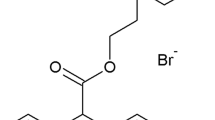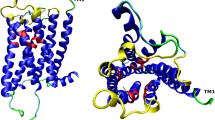Abstract
Direct interactions of the bispyridinium oxime HGG-12 with muscarinic acetylcholine receptors were investigated in porcine cardiac atrial membranes. Competition binding experiments using the radiolabeled muscarinic receptor antagonist (3H)QNB revealed specific binding of HGG-12 to muscarinic acetylcholine receptors of porcine atrial membranes with a dissociation constant of 3.8×10−7 mol/l. Muscarinic acetylcholine receptor-stimulated binding of the radiolabeled GTP analog (35S)GTP[S] to guanine nucleotide binding proteins (G-proteins) was used to study antagonistic and possible agonistic effects of HGG-12 at muscarinic acetylcholine receptors. HGG-12 completely inhibited carbachol- and oxotremorine-stimulated (35S)GTP[S] binding to pertussis toxin sensitive and insensitive G-proteins in a competitive manner. Inhibition constants (KI) of HGG-12 for blockade of carbachol- and oxotremorine-stimulated GTP[S]-binding (9.7×10−7 mol/l and 1.7×10−6 mol/l, respectively) were higher by about a factor of 100 than those of the muscarinic acetylcholine receptor antagonist atropine. In the absence of muscarinic acetylcholine receptor agonists, HGG-12 by itself had no stimulatory effect on (35S)GTP[S] binding in porcine atrial membranes. The results of this study show that the oxime HGG-12 is a competitive antagonist without intrinsic activity at porcine atrial muscarinic acetylcholine receptors. The stimulatory action of HGG-12 on muscarinic acetylcholine receptors which has been described by several authors is, therefore, suggested to be due to partial inhibition of acetylcholinesterase by the oxime rather than to direct agonism at muscarinic acetylcholine receptors.
Similar content being viewed by others
References
Birnbaumer L (1990) G proteins in signal transduction. Annu Rev Pharmacol Toxicol 30: 675–705
Bradford MM (1976) A rapid and sensitive method for the quantitation of microgram quantities of protein utilizing the principle of protein-dye binding. Anal Biochem 72: 248–254
Brown JH, Brown SL (1984) Agonists differentiate muscarinic receptors that inhibit cyclic AMP formation from those that stimulate phosphoinositide metabolism. J Biol Chem 259: 3777–3781
Cheng YC, Prusoff WH (1973) Relationship between the inhibition constant (KI) and the concentration of inhibition which causes 50 per cent inhibition (I50) of an enzymatic reaction. Biochem Pharmacol 22: 3099–3108
Clement JG (1981) Toxicology and pharmacology of bispyridinium oximes — insight into the mechanism of action vs soman poisoning in vivo. Fundam Appl Toxicol 1: S193-S202
Clement JG (1982) HI 6: Reactivation of central and peripheral acetylcholinesterase following inhibition by soman, sarin and tabun in vivo in the rat. Biochem Pharmacol 31: 1283–1287
Clement JG, Lockwood PA (1982) HI 6, an oxime which is an effective antidote of soman poisoning: a structure—activity study. Toxicol Appl Pharmacol 64: 140–146
De Jong LPA, Wolring GZ (1980) Reactivation of acetylcholinesterase inhibited by 1,2,2-trimethylpropyl phosphonofluoridate (soman) with HI-6 and related oximes. Biochem Pharmacol 29: 2379–2387
Dirnhuber P, French MC, Green DM, Leadbeater L, Stratton JA (1979) The protection of primates against soman poisoning by pretreatment with pyridostigmine. J Pharm Pharmacol 31: 295–299
Hilf G, Gierschik P, Jakobs KH (1989) Muscarinic acetylcholine receptor-stimulated binding of guanosine 5′-0-(3-thiotriphosphate) to guanine-nucleotide-binding proteins in cardiac membranes. Eur J Biochem 186: 725–731
Klimmek R, Eyer P (1985) Pharmacokinetics and toxicity of the oxime HGG-12 in dogs. Arch Toxicol 57: 237–242
Kloog Y, Sokolovski M (1985) Bisquaternary pyridinium oximes as allosteric inhibitors of rat brain muscarinic receptors. Mol Pharmacol 27: 418–428
Kloog Y, Galron R, Sokolovski M (1986) Bisquaternary pyridinium oximes as presynaptic agonists and postsynaptic antagonists of muscarinic receptors. J Neurochem 46: 767–772
Kuhnen-Clausen D, Hagedorn I, Gross G, Bayer H, Hucho F (1983) Interactions of bisquaternary pyridine salts (H-oximes) with cholinergic receptors. Arch Toxicol 54: 171–179
Löffelholz K, Pappano AJ (1985) The parasympathetic neuroeffector junction of the heart. Pharmacol Rev 37: 1–24
Lundy PM, Tremblay KP (1979) Ganglion blocking properties of some bispyridinium soman antagonists. Eur J Pharmacol 60: 47–53
Masters SB, Martin MW, Harden TH, Brown JH (1985) Pertussis toxin does not inhibit muscarinic-receptor-mediated phosphoinositol hydrolysis or calcium mobilization. Biochem J 227: 933–937
Scatchard G (1949) The attraction of protein for small molecules and ions. Ann NY Acad Sci 51: 660–672
Schoene K, Steinhanses J, Oldiges H (1983) Reactivation of soman inhibited acetylcholinesterase in vitro and protection against soman in vivo by bispyridinium-2-aldoximes. Biochem Pharmacol 32: 1649–1651
Wolthuis CL, Berends F, Meeter E (1984) Problems in the therapy of soman poisoning. Fundam Appl Toxicol 4: 183–192
Yamada S, Isogai M, Okudaira H, Hayashi E (1983) Correlation between cholinesterase inhibition and reduction in muscarinic receptors and choline uptake by repeated diisopropylfluorophosphate administration: antagonism by physostigmine and atropine. J Pharmacol Exp Ther 226: 519–525
Author information
Authors and Affiliations
Rights and permissions
About this article
Cite this article
Reithmann, C., Berger, H.J., Hilf, G. et al. The oxime HGG-12 as a muscarinic acetylcholine receptor antagonist without intrinsic activity in cardiac membranes. Arch Toxicol 65, 518–523 (1991). https://doi.org/10.1007/BF01977367
Received:
Revised:
Accepted:
Issue Date:
DOI: https://doi.org/10.1007/BF01977367




